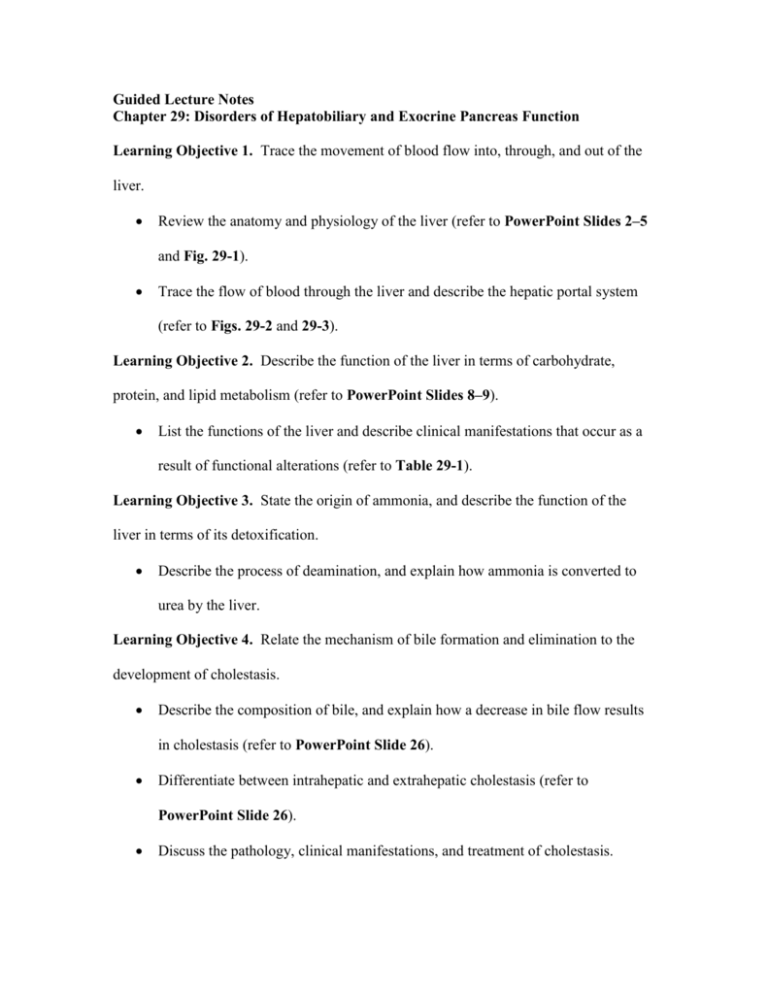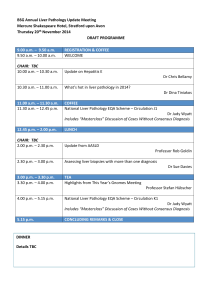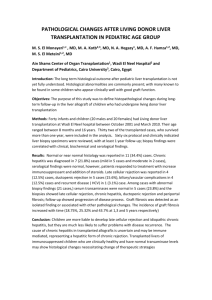Learning Objectives
advertisement

Guided Lecture Notes Chapter 29: Disorders of Hepatobiliary and Exocrine Pancreas Function Learning Objective 1. Trace the movement of blood flow into, through, and out of the liver. Review the anatomy and physiology of the liver (refer to PowerPoint Slides 2–5 and Fig. 29-1). Trace the flow of blood through the liver and describe the hepatic portal system (refer to Figs. 29-2 and 29-3). Learning Objective 2. Describe the function of the liver in terms of carbohydrate, protein, and lipid metabolism (refer to PowerPoint Slides 8–9). List the functions of the liver and describe clinical manifestations that occur as a result of functional alterations (refer to Table 29-1). Learning Objective 3. State the origin of ammonia, and describe the function of the liver in terms of its detoxification. Describe the process of deamination, and explain how ammonia is converted to urea by the liver. Learning Objective 4. Relate the mechanism of bile formation and elimination to the development of cholestasis. Describe the composition of bile, and explain how a decrease in bile flow results in cholestasis (refer to PowerPoint Slide 26). Differentiate between intrahepatic and extrahepatic cholestasis (refer to PowerPoint Slide 26). Discuss the pathology, clinical manifestations, and treatment of cholestasis. Learning Objective 5. Characterize the function of the liver in terms of bilirubin elimination, and describe the difference between unconjugated and conjugated hyperbilirubinemia. Describe the process of bilirubin formation, circulation, and elimination (refer to PowerPoint Slide 27 and Fig. 29-4). Explain the difference between conjugated and unconjugated hyperbilirubinemia. Identify the four causes of jaundice and describe its pathology, signs and symptoms, diagnosis, and treatment (refer to Fig. 29-5 and Chart 29-1). Learning Objective 6. List four laboratory tests used to assess liver function, and relate them to impaired liver function. Identify laboratory and other diagnostic tests that are used to assess liver function, and explain what information is gained by each. Identify the effects of impaired liver function on body systems (refer to PowerPoint Slides 14–15). Learning Objective 7. Compare hepatitis A, B, C, D, and E in terms of source of infection, incubation period, acute disease manifestations, development of chronic disease, and the carrier state. Describe the pathology of hepatitis and differentiate between acute and chronic hepatitis. Differentiate among HAV, HBV, HCV, HDV, and HEV with regard to mode of transmission, incubation period, degree of liver damage, and ability to evolve to a carrier state (refer to PowerPoint Slide 18 and Figs. 29-6–29-8). Learning Objective 8. Define chronic hepatitis, and compare the pathogenesis of chronic autoimmune hepatitis and chronic viral hepatitis. Describe the etiology, incidence, pathology, clinical manifestations, and treatment of chronic hepatitis (refer to PowerPoint Slide 20). Explain the pathologic differences between chronic autoimmune and chronic viral hepatitis. Learning Objective 9. Characterize the metabolism of alcohol by the liver and state metabolic mechanisms that can be used to explain liver injury. Discuss the incidence of alcoholic liver disease and explain how the liver metabolizes alcohol (refer to PowerPoint Slide 21). Describe how alcohol abuse impairs the liver’s ability to metabolize alcohol (refer to Fig. 29-9). Learning Objective 10. Summarize the three patterns of injury that occur with alcoholinduced liver disease. Describe the stages of alcoholic liver disease and compare the pathology, signs and symptoms, and treatment of each stage. Learning Objective 11. Characterize the liver changes that occur with cirrhosis. Describe the pathology, clinical manifestations, and treatment of cirrhosis. Learning Objective 12. Describe the physiologic basis for portal hypertension, and relate it to the development of ascites, esophageal varices, and splenomegaly. Identify numeric values for normal hepatic portal pressures and portal hypertension. Describe the mechanisms of impaired liver function as they relate to portal hypertension (refer to PowerPoint Slides 24–25 and Figs. 29-10 and 29-12). Learning Objective 13. Relate the functions of the liver to the manifestations of liver failure. Discuss the types of liver failure, and quantify the percentage of functional capacity that must be lost before failure occurs. Explain how alterations in liver function lead to the clinical manifestations seen in liver failure (refer to Fig. 29-13). Discuss treatment options for hepatic failure. Learning Objective 14. Characterize etiologies of hepatocellular cancer and state the reason for the poor prognosis in persons with this type of cancer (refer to Fig. 29-14). Discuss the incidence and etiology of liver cancer. Differentiate the two major types of liver cancer with regard to incidence, risk factors, clinical manifestations, and treatment. Learning Objective 15. Explain the function of the gallbladder in regulating the flow of bile into the duodenum. Review the structure and function of the gallbladder (refer to PowerPoint Slide 30). Describe the process by which bile flows from the gallbladder into the duodenum and explain how the gallbladder regulates the pressure in the common bile duct (refer to Fig. 29-15). Learning Objective 16. Describe the formation of gallstones. Describe the causes, composition, and types of gallstones (refer to Fig. 29-16). Identify the factors that contribute to the formation of gallstones. Describe the symptoms, diagnosis, and treatment of gallstones. Learning Objective 17. Describe the clinical manifestations of acute and chronic cholecystitis. Differentiate between acute and chronic cholecystitis with regard to etiology, pathology, signs and symptoms, diagnosis, and treatment (refer to PowerPoint Slide 29). Learning Objective 18. Characterize the effects of choledocholithiasis and cholangitis on the bile flow and the potential for hepatic and pancreatic complications. Define choledocholithiasis and cholangitis and describe clinical manifestations, complications, diagnosis, and treatment (refer to PowerPoint Slide 29). Learning Objective 19. Cite the possible causes and describe the manifestations and treatment of acute pancreatitis. Review the structure and function of the pancreas (refer to PowerPoint Slides 31–32). Identify causes of acute pancreatitis and describe its onset, pathology, symptoms, complications, diagnosis, and treatment. Learning Objective 20. Describe the manifestations of chronic pancreatitis. Identify the two types of chronic pancreatitis and describe associated etiology, pathology, clinical manifestations, and treatment options (refer to PowerPoint Slide 37). Learning Objective 21. State the reason for the poor prognosis in persons with pancreatic cancer. Discuss the incidence and common locations of pancreatic cancer, and discuss possible risk factors. Describe the insidious onset, symptoms, diagnosis, and treatment of pancreatic cancer (refer to PowerPoint Slide 37 and Fig. 29-17).






